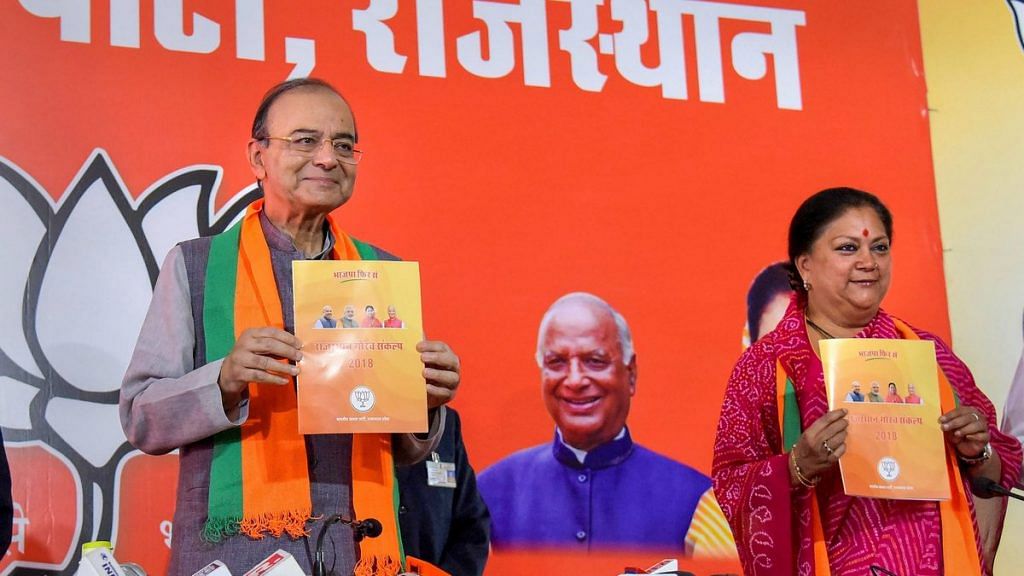Arun Jaitley releasing party manifestoes is BJP’s strategy to ensure that it isn’t just in content but also in the optics that the party is seen as pro-development.
New Delhi: The Bharatiya Janata Party (BJP) appears to be aware that it is facing a stern test in the ongoing state assembly elections, and is making sure that each of its poll moves are well thought-out, with carefully crafted messages.
On Tuesday, Finance Minister Arun Jaitley released the party’s manifesto for the Rajasthan elections. Highly-placed sources in the party said that getting the finance minister to release manifestos in key states where the party is facing anti-incumbency was not an arbitrary decision.
The optics behind Jaitley releasing the poll documents is a message that the BJP “stands for vikas (development) and economic growth” while sidestepping the Hindutva angle.
Jaitley had also released the manifesto for Madhya Pradesh on 17 November, along with Chief Minister Shivraj Singh Chouhan.
The manifesto for Rajasthan, released by Jaitley along with Chief Minister Vasundhara Raje in Jaipur, promises 50 lakh jobs in the private sector and Rs 5,000 per month unemployment allowance to eligible youth.
“Jaitley, being the finance minister and a policy person, has the image of being a modern face of the BJP, and it helps send out the message of the party being development and growth-oriented,” said a source in the BJP who did not wish to be identified.
“This is much needed in states where we are fighting anti-incumbency, especially to appeal to the aspirations of the youth.”
It isn’t just in the content of the manifestos, but also in the optics of its release that the BJP wants to be seen as a growth-oriented party.
Also read: Madhya Pradesh is Shivraj Singh Chouhan’s election – to win or lose
Vikas & Hindutva
Sources in the party say this is a “two-pronged strategy” — to steer clear of religion in the manifesto, and the packaging of it, while leaving it to its leaders and cadre on the ground to push its majoritarian Hindutva appeal.
“The finance minister is not seen as a Hindutva face of the BJP, making him a neutral candidate to release manifestos. We want to seem visionary in this respect,” said a party leader in Madhya Pradesh, also on condition of anonymity.
“We have the medium of rallies and ground-level campaigns to highlight issues such as Hindutva, Ram temple and the Congress’ double standards on religion, among others.”
In Madhya Pradesh, for instance, the BJP released two manifestos — Drishti Patra (vision document) and Naari Shakti Sankalpa Patra (women empowerment document) — staying away from any overtly religious messaging, ironically, unlike the Congress.
Even in Chhattisgarh, where the manifesto was released by party president Amit Shah, his speech at the release focused on the economic development of the state, welfare measures as well as the government’s efforts to eliminate Naxalism.
In its campaign otherwise, the BJP barely shies away from raising provocative issues with religious undertones.
PM Narendra Modi, for instance, raked up the issue of the Ram temple and blamed the Congress for the delay in its construction at the disputed site in Ayodhya during a rally in Alwar.
Shah, meanwhile, has been at the forefront of talking about driving out “Bangladeshi infiltrators” from the country in his campaign speeches across poll-bound states, giving it a clear communal angle by talking about giving citizenship to Hindu immigrants in the same breath.
In another instance last week, Uttar Pradesh Chief Minister Yogi Adityanath at a public rally in Bhopal took a dig at Congress leader Kamal Nath for asking Muslim leaders to ensure votes from the minority community. “Keep your Ali, Bajrang Bali is enough for us,” Adityanath said.
In its campaign on the ground, the BJP’s voter outreach is facilitated by its cadres and the Rashtriya Swayamsevak Sangh (RSS) who have an open mandate of talking about issues like BJP’s commitment to building the Ram temple at Ayodhya, Congress’ “politics of appeasement” and questioning Rahul Gandhi’s visit to temples ahead of elections
Moreover, by getting its senior, national leaders to share the dais with chief ministers while releasing manifestos, the BJP wants to show its top leadership is throwing its weight behind the state leaders while indicating the importance of the polls to the party.
The Congress, meanwhile, saw Gandhi release the Chhattisgarh manifesto — a state where it is bereft of effective leadership — but only the state’s top leaders were present during the Madhya Pradesh release. The party is yet to come out with a manifesto for Rajasthan.
Also read: Navjot Singh Sidhu is the Congress’ new star campaigner, even in Telangana & Rajasthan
